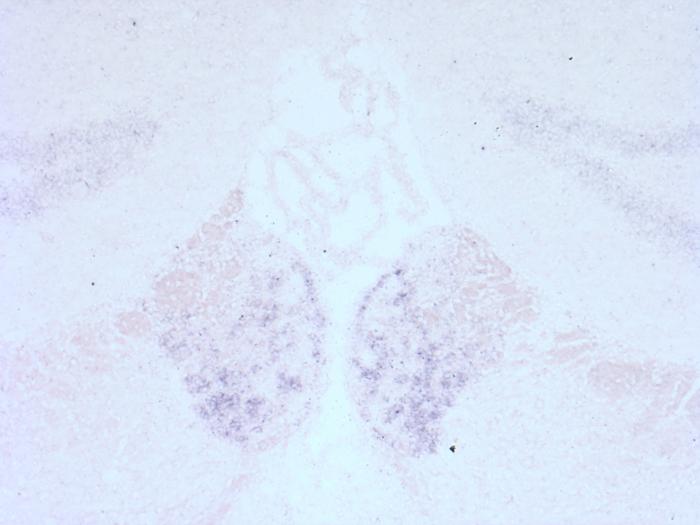LA JOLLA, CA— Ethanol—the compound found in alcoholic beverages—interferes with the normal functioning of a long list of biological molecules, but how each of these interactions contributes to the behavioral effects of alcohol is not fully understood. A guiding, but elusive, goal of researchers is to identify the protein (or proteins) to which ethanol binds that makes some people vulnerable to excessive drinking. Solving this question would point the way to effective therapies for alcohol use disorder, which affects more than 10% of the U.S. adult population and is responsible for a myriad of health and societal issues.

Credit: Contet et al./Molecular Psychiatry
LA JOLLA, CA— Ethanol—the compound found in alcoholic beverages—interferes with the normal functioning of a long list of biological molecules, but how each of these interactions contributes to the behavioral effects of alcohol is not fully understood. A guiding, but elusive, goal of researchers is to identify the protein (or proteins) to which ethanol binds that makes some people vulnerable to excessive drinking. Solving this question would point the way to effective therapies for alcohol use disorder, which affects more than 10% of the U.S. adult population and is responsible for a myriad of health and societal issues.
Previous studies identified one such molecule, a protein widely expressed in the brain, called the BK channel. Ethanol can directly interact with a component of BK channels, known as the α subunit, to facilitate their opening. However, scientists at Scripps Research found that this interaction may not drive behaviors related to alcohol abuse as much as previously thought. Their study, appearing in the journal Molecular Psychiatry on December 22, 2023, demonstrates that preventing ethanol from interacting with the BK α subunit does not reduce or increase the motivation to consume alcohol in mice.
The relationship between the BK α subunit and ethanol had previously been explored in vitro, ex vivo and in live invertebrates. Previous studies suggested that the BK α subunit was involved in an animal’s response to alcohol exposure, but there was a gap in understanding its role in mammals, particularly for the control of alcohol drinking.
“Knowing what a molecule does from in vitro experiments really doesn’t tell you much about what the behavioral consequences of that action might be,” says senior author Candice Contet, PhD, associate professor in the Department of Molecular Medicine at Scripps Research. “Things get complicated in vivo, because there are many layers of modulation that may occur in a cell-type specific manner. Moreover, the initial effect often changes with repeated or prolonged exposure to alcohol. We thus sought to determine whether the ability of ethanol to alter BK channel activity was in any way influencing the motivation to drink alcohol.”
Tackling this question didn’t lend itself well to conventional pharmacological testing: blocking BK channels with a drug causes tremors, which then interfere with drinking behavior. However, Contet’s collaborator Alex Dopico, MD, PhD, of the University of Tennessee, had identified a residue in the mouse BK α subunit that is required for ethanol to activate BK channels but is dispensable for normal BK channel activity, as shown in frog eggs. In the new study, Contet and her colleagues leveraged this discovery to unlock the significance of ethanol’s interaction with BK channels for alcohol drinking in mice.
Accordingly, the team tested mice that had a mutation in this particular BK α subunit residue. First, they found that the mutation prevented alcohol from altering the firing properties of neurons in the medial habenula, a brain region with high levels of BK channels, thereby demonstrating that it also confers resistance to ethanol in mouse brain cells, not just in frog eggs. At the behavioral level, the mice harboring the mutation did not display any anomalies when compared to control littermates. Notably, they exhibited the standard signs of intoxication upon alcohol injection, such as loss of balance and hypothermia, and they consumed the same amount of alcohol when tested under various conditions of moderate or excessive drinking.
“The lack of effect of the mutation was surprising, especially in light of our previous results showing that other BK channel subunits, β1 and β4, influence alcohol intake escalation in the same model of alcohol dependence,” says Contet. “However, these negative results, which were replicated in multiple cohorts and both sexes, are just as important as positive ones, because they encourage the field to study other targets rather than focusing on the wrong culprit.”
While the study does not point to a critical role of the BK α subunit in the motivation to drink alcohol or several physiological responses related to ethanol intoxication and withdrawal, the group will continue to explore whether the molecular target plays a role in other aspects of alcohol use disorder.
“Ethanol is highly pleiotropic. Beyond its reinforcing effects, it alters the functioning of multiple organs and cell types,” Contet says. “It is likely that ethanol’s interaction with BK channels contribute to some of these effects, but we’ve only explored the tip of the iceberg so far; the next challenge will be to find the right experimental readout.”
In addition to Contet, authors of the study, “Ethanol’s interaction with BK channel α subunit residue K361 does not mediate behavioral responses to alcohol in mice,” include Agbonlahor Okhuarobo, Max Kreifeldt, Pauravi Gandhi, Catherine Lopez, Briana Martinez, Kiera Fleck, Michal Bajo, Pushpita Bhattacharyya, Marisa Roberto and Amanda Roberts of Scripps Research; Alex Dopico of the University of Tennessee Health Science Center; and Gregg Homanics of the University of Pittsburgh.
This work was supported by funding from the National Institutes of Health (AA020913, AA006420, AA026685, AA027636, AA027372, AA020889, AA010422, AA021491, AA013498, AA011560, AA007456)
About Scripps Research
Scripps Research is an independent, nonprofit biomedical institute ranked one of the most influential in the world for its impact on innovation by Nature Index. We are advancing human health through profound discoveries that address pressing medical concerns around the globe. Our drug discovery and development division, Calibr, works hand-in-hand with scientists across disciplines to bring new medicines to patients as quickly and efficiently as possible, while teams at Scripps Research Translational Institute harness genomics, digital medicine and cutting-edge informatics to understand individual health and render more effective healthcare. Scripps Research also trains the next generation of leading scientists at our Skaggs Graduate School, consistently named among the top 10 US programs for chemistry and biological sciences. Learn more at www.scripps.edu.
Journal
Molecular Psychiatry




